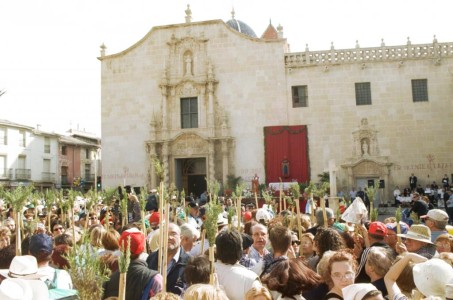LA SANTA FAZ
(English version below)
LA SANTA FAZ
El monasterio de La Santa Faz, de estilo barroco, está ubicado a cinco kilómetros del casco urbano, en la pedanía del mismo nombre. En su interior guarda una reliquia traída del Vaticano en el siglo XV que, según la tradición popular, fue el lienzo con el que la Verónica secó el rostro ensangrentado de Jesús camino del Calvario.
Cada año, el segundo jueves después del Domingo de Resurrección, miles de alicantinos, muchos de ellos ataviados su típico blusón negro, su pañuelo de cuadros anudado al cuello y ayudados por una caña que luce en su extremos una ramita de romero, caminan durante aproximadamente un par de horas con el fin de realizar la denominada Romería de la Peregrinación de la Santa Faz, siendo ésta la segunda romería en importancia de España después del Rocío. En su interior hay un camarín tras el retablo mayor donde se custodia las reliquias de la Santa Faz.
Una vez llegados al Monasterio, los peregrinos esperan pacientemente a la apertura del camarín que recoge tan preciada reliquia y sólo los más afortunados, ya que debido a la gran cantidad de devotos no es fácil conseguir un sitio, conseguirán presenciar el acto donde seguidamente tiene lugar la celebración de la misa. En los alrededores del Monasterio los miles de asistentes, la mayoría familias, continúan la fiesta con sus manjares traídos desde casa, juegos, visitas a los puestos artesanales y a la feria.

LA SANTA FAZ
The monastery of La Santa Faz, in Baroque style, is located five kilometres from the town centre, in the hamlet of the same name. It houses a relic brought from the Vatican in the 15th century which, according to popular tradition, was the cloth with which Veronica wiped the bloodied face of Jesus on his way to Calvary.
Every year, on the second Thursday after Easter Sunday, thousands of people from Alicante, many of them dressed in their typical black smock, with their chequered scarf knotted around their necks and helped by a cane with a sprig of rosemary at the end, walk for a couple of hours for the so-called Pilgrimage of the Pilgrimage of the Santa Faz, the second most important pilgrimage in Spain after the Rocío. Inside there is a chapel behind the main altarpiece where the relics of the Santa Faz are kept.
Once arrived at the Monastery, the pilgrims wait patiently for the opening of the chapel that holds such a precious relic and only the luckiest ones, as due to the large number of devotees it is not easy to get a place, will be able to witness the act where the celebration of the mass takes place afterwards. Around the Monastery, the thousands of people, mostly families, continue the festivities with food brought from home, games, visits to the craft stalls and the fair.
